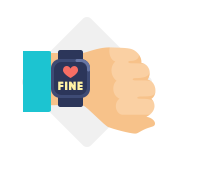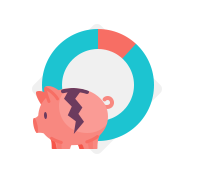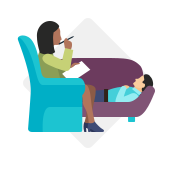
I just learned that April is Stress Awareness Month. So what has Florida stressed out? A lot of different things, actually. According to Wallethub, 83% of adults are stressed out from inflation. But there's so many other things to worry about, too. Like Fort Myers traffic. Or Naples insane rent prices. And hurricanes. Taking a look at the overall state, let's see how Florida stacks up against the others.
To determine the states with the highest stress levels, WalletHub compared all 50 states across 41 key metrics. The diverse data set ranges from average hours worked per week, the personal bankruptcy rate, to the share of adults getting adequate sleep. A lot of these factors can compound each other. Here's how Florida ranks against the other states. It seems like we aren't worried about losing our jobs, but we are worried about our spouse and whether or not we can pay rent!
Stress Levels in Florida (1=Most Stressed, 25=Avg.):
- 22nd – Avg. Hours Worked per Week
- 19th – Share of Adults Getting Adequate Sleep
- 34th – % of Adults in Fair/Poor Health
- 49th – Job Security
- 15th – Median Credit Score
- 7th – Housing Affordability
- 18th – % of Population Living in Poverty
- 5th – Divorce Rate
- 26th – Crime Rate per Capita
- 16th – Psychologists per Capita
The job security part actually makes sense as Florida has a very low unemployment rate of 2.6%, and forecasted faster-than-national average economic growth rate. I think if they just polled Southwest Florida, 'driving in traffic' would rank high on the stress test. So how do we rank up against everyone else? Middle of the pack, actually.
Most Stressed States
| Overall Rank* | State | Total Score | Work-Related Stress | Money-Related Stress | Family-Related Stress | Health- & Safety-Related Stress |
|---|---|---|---|---|---|---|
| 1 | Mississippi | 58.80 | 4 | 1 | 9 | 7 |
| 2 | Louisiana | 58.32 | 3 | 4 | 18 | 3 |
| 3 | New Mexico | 58.24 | 26 | 3 | 1 | 17 |
| 4 | West Virginia | 57.58 | 15 | 6 | 6 | 2 |
| 5 | Nevada | 57.17 | 12 | 10 | 2 | 12 |
| 6 | Arkansas | 55.23 | 9 | 5 | 26 | 1 |
| 7 | Alabama | 54.55 | 27 | 2 | 15 | 6 |
| 8 | Kentucky | 53.41 | 22 | 8 | 19 | 5 |
| 9 | Texas | 53.34 | 5 | 23 | 5 | 11 |
| 10 | Oklahoma | 52.76 | 13 | 12 | 14 | 8 |
| 11 | Tennessee | 52.70 | 18 | 9 | 29 | 4 |
| 12 | Arizona | 49.38 | 39 | 11 | 10 | 20 |
| 13 | Alaska | 49.08 | 1 | 40 | 37 | 16 |
| 14 | South Carolina | 48.55 | 23 | 27 | 12 | 10 |
| 15 | Georgia | 48.03 | 11 | 15 | 36 | 13 |
| 16 | Wyoming | 48.02 | 2 | 31 | 43 | 14 |
| 17 | North Carolina | 47.38 | 38 | 21 | 4 | 25 |
| 18 | Oregon | 46.73 | 37 | 7 | 24 | 23 |
| 19 | Indiana | 45.67 | 40 | 18 | 31 | 15 |
| 20 | New York | 45.46 | 21 | 35 | 3 | 44 |
| 21 | Michigan | 45.31 | 42 | 29 | 11 | 18 |
| 22 | California | 45.26 | 36 | 22 | 8 | 30 |
| 23 | Ohio | 45.14 | 29 | 24 | 27 | 19 |
| 24 | Florida | 43.58 | 46 | 20 | 7 | 36 |
| 25 | Washington | 43.20 | 32 | 30 | 16 | 27 |
| 26 | Montana | 43.12 | 48 | 16 | 28 | 21 |
| 27 | Illinois | 43.01 | 19 | 37 | 13 | 37 |
| 28 | Maine | 42.69 | 33 | 13 | 34 | 31 |
| 29 | Delaware | 42.00 | 10 | 34 | 20 | 41 |
| 30 | Colorado | 41.64 | 34 | 28 | 23 | 29 |
| 31 | Pennsylvania | 41.64 | 20 | 33 | 32 | 32 |
| 32 | Kansas | 41.50 | 25 | 36 | 41 | 22 |
| 33 | Missouri | 41.32 | 41 | 32 | 46 | 9 |
| 34 | Maryland | 40.31 | 7 | 46 | 17 | 45 |
| 35 | Wisconsin | 39.60 | 30 | 38 | 33 | 33 |
| 36 | Idaho | 39.14 | 47 | 14 | 45 | 24 |
| 37 | Rhode Island | 38.40 | 43 | 26 | 21 | 48 |
| 38 | Nebraska | 38.23 | 24 | 41 | 40 | 40 |
| 39 | Hawaii | 37.66 | 8 | 25 | 44 | 50 |
| 40 | Vermont | 37.64 | 49 | 19 | 25 | 39 |
| 41 | Virginia | 37.53 | 14 | 45 | 30 | 46 |
| 42 | North Dakota | 37.28 | 6 | 44 | 48 | 34 |
| 43 | Connecticut | 37.17 | 31 | 43 | 22 | 47 |
| 44 | New Jersey | 36.59 | 17 | 48 | 39 | 42 |
| 45 | Iowa | 36.59 | 28 | 49 | 42 | 35 |
| 46 | Massachusetts | 36.55 | 16 | 39 | 38 | 49 |
| 47 | South Dakota | 35.15 | 35 | 42 | 50 | 26 |
| 48 | New Hampshire | 34.97 | 45 | 47 | 35 | 38 |
| 49 | Utah | 34.36 | 50 | 17 | 49 | 28 |
| 50 | Minnesota | 30.42 | 44 | 50 | 47 | 43 |
Notes: *No. 1 = Most Stressed
With the exception of “Total Score,” all of the columns in the table above depict the relative rank of that state, where a rank of 1 represents the worst conditions for that metric category.
Avg. Hours Worked per Week
- 1. Texas
- 2. Alaska
- T-3. North Dakota
- T-3. Wyoming
- 5. Louisiana

- T-45. Connecticut
- T-45. Massachusetts
- 47. Oregon
- 48. Rhode Island
- 49. Vermont
- 50. Utah
Avg. Hours of Sleep per Night
- 1. West Virginia
- 2. Hawaii
- 3. Alabama
- 4. Kentucky
- 5. Pennsylvania

- 46. South Dakota
- 47. Nebraska
- 48. Vermont
- 49. Minnesota
- 50. Colorado
% of Adults in Fair/Poor Health
- 1. Kentucky
- 2. Mississippi
- 3. West Virginia
- 4. Arkansas
- 5. Louisiana

- 46. Minnesota
- 47. Vermont
- T-48. Massachusetts
- T-48. New Hampshire
- 50. Hawaii
Job Security
- 1. Maine
- 2. Wisconsin
- 3. Kansasa
- 4. Mississippi
- 5. Nebraska

- 46. California
- 47. Nevada
- 48. North Carolina
- 49. Florida
- 50. Connecticut
Credit Score
- 1. Mississippi
- 2. Louisiana
- T-3. Alabama
- T-3. Arkansas
- T-3. Oklahoma

- T-46. Massachusetts
- T-46. North Dakota
- 48. Vermont
- 49. New Hampshire
- 50. Minnesota
Affordable Housing
- 1. California
- 2. Hawaii
- 3. New York
- 4. Oregon
- 5. Massachusetts

- 46. Ohio
- 47. Indiana
- 48. Kansas
- 49. Nebraska
- 50. Iowa
% of Population Living in Poverty
- 1. Mississippi
- 2. Louisiana
- 3. New Mexico
- 4. West Virginia
- 5. Kentucky

- 46. Hawaii
- T-47. Maryland
- T-47. Minnesota
- 49. Utah
- 50. New Hampshire
Divorce Rate
- 1. New Mexico
- 2. Nevada
- 3. Louisiana
- 4. Mississippi
- 5. Florida

- 46. Nebraska
- 47. Hawaii
- 48. New Jersey
- 49. North Dakota
- 50. Utah
Crime Rate per Capita
- 1. Louisiana
- 2. Alabama
- 3. Nevada
- 4. South Carolina
- 5. Georgia

- 46. Wisconsin
- 47. New York
- 48. Rhode Island
- 49. Illinois
- 50. Massachusetts
Methodology
In order to determine the most and least stressed states, WalletHub compared the 50 states across four key dimensions: 1) Work-Related Stress, 2) Money-Related Stress, 3) Family-Related Stress, 4) Health- & Safety-Related Stress.
We evaluated those dimensions using 41 relevant metrics, which are listed below with their corresponding weights. Each metric was graded on a 100-point scale, with a score of 100 representing the highest level of stress.
We then determined each state’s weighted average across all metrics to calculate its overall score and used the resulting scores to rank-order the states.
Work-Related Stress – Total Points: 25
- Average Hours Worked per Week: Double Weight (~5.26 Points)
- Average Commute Time: Half Weight (~1.32 Points)
- Average Leisure Time Spent per Day: Full Weight (~2.63 Points)
- Job Security: Full Weight (~2.63 Points)
- Unemployment Rate: Double Weight (~5.26 Points)
- Underemployment Rate: Full Weight (~2.63 Points)
- Income Growth Rate (2021 vs. 2020): Double Weight (~5.26 Points)
Money-Related Stress – Total Points: 25
- Median Income: Double Weight (~3.57 Points)
Note: Adjusted for cost of living. - Debt per Median Earnings: Full Weight (~1.79 Points)
- Median Credit Score: Full Weight (~1.79 Points)
- Personal Bankruptcy Rate: Double Weight (~3.57 Points)
- Share of Adults with Financial Anxiety: Double Weight (~3.57 Points)
Note: This metric measures the percentage of adults who agree that thinking about their personal finances makes them feel anxious. - Economic Security Score: Full Weight (~1.79 Points)
Notes: This metric is based on Sharecare’s “Community Well-Being Index", particularly the “Economic Security” element, defined as “community members who are employed, insured, and otherwise stable financially.” - Share of People Unable to Save for Children’s College: Full Weight (~1.79 Points)
- Share of Adults Paying Only Minimum on Credit Card(s): Full Weight (~1.79 Points)
- Share of Population Living in Poverty: Full Weight (~1.79 Points)
- Housing Affordability: Double Weight (~3.57 Points)
Note: This metric was calculated as follows: Housing Costs (accounts for both rental and sale prices) / Median Annual Household Income.
Family-Related Stress – Total Points: 25
- Separation and Divorce Rate: Full Weight (~2.78 Points)
- Share of Single Parents: Full Weight (~2.78 Points)
- Cost of Childcare: Triple Weight (~8.33 Points)
Note: Adjusted for median household income. - “Parental-Leave Policy” Score: Full Weight (~2.78 Points)
- Parental Stress: Full Weight (~2.78 Points)
Note: This composite metric considers the percentage of parents who felt angry with their child, felt the child does things to bother them or felt the child is difficult to care for. - Share of Parents Without Emotional Support: Full Weight (~2.78 Points)
Note: This metric measures the percentage of parents who do not have someone they can turn to for day-to-day emotional support with parenting or raising children. - Share of Parents Who Changed /Quit Jobs Due to Problems with Child Care: Full Weight (~2.78 Points)
Health- & Safety-Related Stress – Total Points: 25
- Percentage of Residents 5+ Who Are Fully Vaccinated Against COVID-19: Quadruple Weight (~4.26 Points)
- Share of Adults in Fair or Poor Health: Double Weight (~2.13 Points)
- Share of Adults Diagnosed with Depression: Full Weight (~1.06 Points)
- Mental Health: Double Weight (~2.13 Points)
- Suicide Rate: Full Weight (~1.06 Points)
- Unaffordability of Doctor Visits: Full Weight (~1.06 Points)
Note: Measures percentage of adults aged 18 and older who reported not seeing a doctor in the past 12 months due to cost. - Share of Parents Frustrated in Efforts to Get Health Services for Their Child: Full Weight (~1.06 Points)
Note: This metric measures the share of parents frustrated in their efforts to get health services for their child in the past 12 months. - Increase in Annual Health Insurance Premiums: Double Weight (~2.13 Points)
- Share of Insured Population: Double Weight (~2.13 Points)
Note: “Population” includes noninstitutionalized civilians aged 16 and older. - Psychologists per Capita: Full Weight (~1.06 Points)
- Physical Activity Rate: Half Weight (~0.53 Points)
- Share of Adults Getting Adequate Sleep: Full Weight (~1.06 Points)
Note: Measures percentage of adults aged 18 and older who reported getting seven or more hours of sleep per 24-hour period. - Bullying Incidents Rate: Full Weight (~1.06 Points)
Note: Measures both the percentage of high school students who were bullied on school property and the percentage of high school students who were bullied electronically/online. - Crime Rate per Capita: Full Weight (~1.06 Points)
- Hate-Crime Incidents per Capita: Full Weight (~1.06 Points)
- Well-Being Index: Full Weight (~1.06 Points)
- Quality of Infrastructure: Full Weight (~1.06 Points)
Note: “Infrastructure” refers to roads and bridges.
Sources:
Data used to create this ranking were collected from U.S. Census Bureau, Bureau of Labor Statistics, Centers for Disease Control and Prevention, FINRA Investor Education Foundation, Council for Community and Economic Research, Administrative Office of the United States Courts, TransUnion, U.S. Department of Housing and Urban Development, Child Care Aware of America, National Partnership for Women & Families, Sharecare’s “Community Well-Being Index”, Child and Adolescent Health Measurement Initiative, Federal Bureau of Investigation, Kaiser Family Foundation and The Road Information Program.





